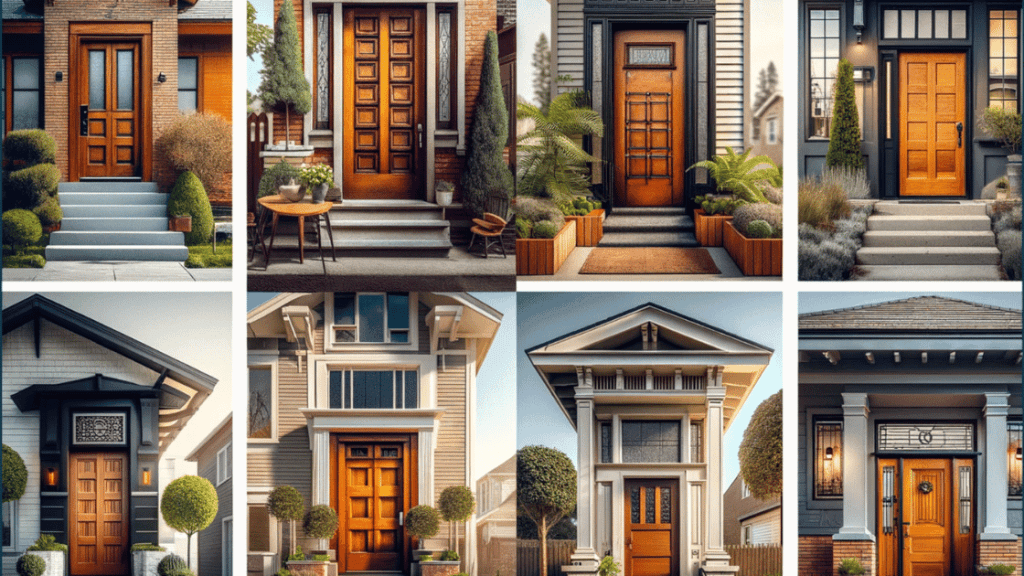The Resurgence of 1930s Door Styles in Contemporary Homes
| Key Takeaways | Description |
| Introduction to 1930s Door Style | These doors are more than mere entryways; they're historical artefacts echoing a bygone era's craftsmanship. |
| Variations of 1930s Door Styles | Doors from this period, like our own 1930s style doors, are more than functional; they're a homage to an era that valued both form and function, beauty and utility. |
| Materials and Construction of 1930s Doors | This decade's doors are known for their durability and the skilled craftsmanship that went into making them. |
| FAQs & Common Concerns | 1930s doors are typically made from high-quality woods such as oak, pine, or walnut, with glass features being common for added decorative effect. |
Introduction to 1930s Door Style
The door designs of the 1930s are a striking example of the distinctive style of that century, combining classic elegance with the new modernism of the day. These doors are historical relics that echo with the artistry of a bygone period; they are more than just useful entrances. The 1930s door styles are characterised by a number of essential elements, such as strong, geometric shapes that emanate refinement and inventiveness. These doors are renowned for their sturdy design, which exudes a substantial, weighty feel that is a reflection of the period's strong craftsmanship. In terms of aesthetics, bright and dark wood tones are frequently used in 1930s doors, giving their look warmth and richness. Stained glass or frosted glazing is a common feature on these doors, adding a touch of refinement and artistry to their design. These doors frequently have elaborate sunburst designs or chevrons on them, which highlight the period's aesthetic and ornamental sensibility. 1930s door styles are essentially a unique combination of design features that encapsulate the spirit of a significant historical era, transforming them from entryways into treasured artefacts from a bygone era.Notable Architects and Buildings Featuring 1930s Door Styles
| Architect | Building | Location |
| George Grey Wornum | RIBA Building | London, UK |
| Raymond Hood | Rockefeller Center | New York, USA |
| Lutyens & Fry | Britannic House | London, UK |
The Rise of 1930s Door Styles in Modern Homes
The resurgence of 1930s door styles within contemporary settings is an intriguing trend in the modern housing landscape. This revival can be seen as a confluence of nostalgia and the timeless allure of artisanship, compelling homeowners to blend historical aesthetics with modern comforts. First of all, there is an intense sentimental appeal to these doors, a great longing for the palpable artistry and workmanship of bygone ages. People are drawn to these doors because of the genuine and elaborate details that evoke a bygone era in which fine craftsmanship was highly prized.
Unique Appeal of 1930s Door Styles in Contemporary Settings
| Feature | Appeal in Modern Homes |
| Stained Glass Elements | Adds a touch of colour and privacy |
| Solid Wood Construction | Ensures longevity and sturdiness |
| Art Deco Influences | Provides an elegant, vintage flair |

Characteristics and Variations of 1930s Door Styles
The 1930s was a decade of stylistic innovation that brought forth door styles which combined the charm of traditional craftsmanship with the sleek lines of modern design. These styles often reflect the broader architectural trends of the era, such as Art Deco and Streamline Moderne. Art Deco Doors are known for their dramatic geometric patterns and luxury materials. These doors embody Art Deco with their complex, lavish decorations. In contrast, Streamline Moderne Doors have smooth lines, rounded shapes, and a mild nautical element. They are sleek and stylish, making them ideal for people who want a more modern look. Instead, Craftsman Doors emphasise handmade craftsmanship with linear lines and wood-heavy patterns. These doors showcase the Arts and Crafts movement's craftsmanship and artisanal talents, filling homes with warmth. Finally, Mission Doors are simple with straight lines and minimal adornment. The Mission style emphasises utility and unadorned materials, and these doors emphasise wood's natural beauty. These door types suit different design tastes and architectural trends.Variations of 1930s Door Styles
| Type | Description | Materials Used |
| Art Deco | Geometric, ornate, luxurious | Metals, exotic wood |
| Streamline Moderne | Aerodynamic, smooth, nautical | Light woods, chrome fittings |
| Craftsman | Handmade quality, simple lines | Oak, pine, durable hardwoods |
| Mission | Minimalist, focus on wood quality | Oak, often with iron hardware |
Materials and Construction of 1930s Doors
Quality materials and careful workmanship were the norm in the 1930s. This decade's doors are renowned for their durability and skillful craftsmanship. Oak, pine, and walnut are common woods for these doors. Natural strength and timeless appeal made wood a popular material for making durable doors. The 1930s doors also used leaded or stained glass for ornamental panels. This enhanced elegance and let in natural light while keeping privacy. Metal hardware improved the functionality and beauty of these doors. Hardware including handles, knobs, hinges, and decorative accents were made of brass, bronze, and iron. Doors from the 1930s are cherished architectural artefacts due to their durability and beauty.Construction Techniques and Methods
| Technique | Description |
| Mortise and Tenon | A strong joint that withstands the test of time |
| Dovetailing | Interlocking joints for drawer construction |
| Glazing | Technique for securing glass panels within the door frame |
Hardware and Accessories for 1930s Doors
Hardware and accessories are the jewellery of doors, providing not just function but also form. For 1930s doors, the hardware is often as distinctive as the doors themselves. The craftsmanship and attention to detail of 1930s doors is evident in their hardware. Elegant door knobs and levers with intriguing geometric forms lend refinement to these doors. These hardware features enhance the door's aesthetics and functionality. Along with door knobs and levers, 1930s door hinges are sturdy and ornamental. These hinges are beautiful additions that enhance the door's beauty. Door locks and latches from this era are ornamental and useful. They're secure and easy to operate while matching the door's style. Elegant door knobs, ornamental hinges, and artistic yet practical locks and latches illustrate the 1930s' excellent craftsmanship and attention to detail, making these doors durable and beautiful.Popular Hardware and Accessory Options
| Accessory | Description |
| Brass Door Knobs | Polished finish, often with octagonal shapes |
| Stained Glass Panels | Custom designs that provide colour and privacy |
| Iron Hinges | Heavy-duty with decorative details |

Contemporary Applications of 1930s Door Designs
While the 1930s were a time of distinct design styles, these historical elements can be beautifully integrated into modern homes, providing a blend of classic elegance and contemporary sleekness.- Contrast and Complement: Modern interiors often play with a mix of old and new elements, where a 1930s style door can serve as a stunning focal point.
- Period Homes Renovation: For those restoring or renovating period homes, incorporating authentic 1930s doors, like those in our Period doors range, is essential to maintaining the home's historical integrity.
- New Builds with Character: Even in new construction, architects and designers may choose a 1930s door to add instant character and a sense of history to a home.
Modern Spaces Featuring 1930s Doors
| Space | Application |
| Urban Lofts | A bold 1930s door contrasts with industrial elements |
| Minimalist Interiors | Adds warmth and texture to a clean, modern design |
| Classic Townhouses | Complements the architectural heritage of the building |
Benefits of 1930s Door Styles in Modern Decor
Modern dwellings benefit from 1930s door styles beyond their aesthetics. First and foremost, their classic style adds elegance to any room. Homeowners wanting an elegant touch choose these doors because they can enhance a room's atmosphere and decor. Another virtue of 1930s doors is durability. These solid wood doors, like our Oak doors, are meant to last. They're a good house investment because of their durable build. The adaptability of 1930s doors is also notable. A 1930s door can blend into your home's modern minimalist or classic decor. Their versatility to match many interior styles makes them a versatile alternative for different design tastes. 1930s door types combine classic aesthetics, durability, and versatility to improve modern house appeal and functionality.Advantages of 1930s Door Styles
| Advantage | Description |
| Timeless Design | Never goes out of style and works with various decor themes |
| Craftsmanship | Superior construction means longevity and enduring beauty |
| Character Addition | Adds a distinct charm and history to newer homes |
Personalising 1930s Doors for Modern Homes
Personalising a 1930s door allows homeowners to maintain the door’s classic appeal while tailoring it to their modern aesthetic and lifestyle needs.- Colour Choices: While traditional 1930s doors may feature natural wood finishes, modern interpretations can be painted in contemporary hues, including options like our Grey doors or Black doors.
- Hardware Updates: Updating hardware is a simple way to modernise a 1930s door. Sleek, modern hardware can provide a fresh look while maintaining the door's classic lines.
- Glass Inserts: Incorporating glass panels, like those in our Glazed doors, can bring light into a space and bridge the gap between old and new.


